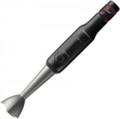Grinding bowl
The working volume of the grinding bowl, supplied with the device.
For more information about the bowl for grinding, see "Capacities". And the amount of product that can be grinded in the device in one load directly depends on its volume. At the same time, keep in mind that a larger bowl takes up more space, costs more, and also requires a more powerful engine. Therefore, manufacturers usually select this volume taking into account the overall level and performance of the device.
Shaker volume
The working volume of the shaker supplied with the device.
For more information about such containers, see "Shaker (travel bowl)". And on the one hand, the actual capacity of the shaker directly depends on the volume, on the other hand, its dimensions, as well as the requirements for engine power. However, in most models, this indicator ranges from 300 to 700 mL, less often up to 1 liter — these values are considered optimal, taking into account the specifics of the use of shakers.
One button control
Models of blenders, the control of which is reduced to
one button, and the speed of work depends on the force of pressing. This solution allows you to work with one hand and change the operating modes with the same hand, while the other can fill up the ingredients and not stop the process.
Turbo mode
Turbo mode allows you to significantly increase the speed of rotation of the mixer nozzles for a short time. In this way, unevenness in the whipped product can be quickly and efficiently eliminated, which is especially valuable at the end of whipping. However, note that the turbo mode can only be turned on for a short time, otherwise there is a risk of overheating of the motor.
Shaker (travel bowl)
The number of travel shaker bowls supplied with the appliance.
These bowls are supplied exclusively with blenders of different types (see "Type of device"). A shaker is a capacity, most often in the form of a tall glass, which can be removed from the device, tightly closed and carried with you without fear of pouring the contents. In such capacities, two lids are usually used: a working lid with chopping knives (a bowl with such a lid is placed on the blender with the bottom up), and a “travel” lid, which can be equipped with a valve for easy drinking. Shakers are very popular among smoothie lovers: they allow you to prepare your favorite drink and take it with you without fiddling with pouring from a bowl to another capacity.
Nozzles
—
Blending arm. A blending nozzle is a long rod-like attachment with a protective cap at one end, containing a bladed knife. It can be attached to a conventional mixer, essentially turning it into a blender.
—
Wide blending arm. A blending nozzle, or blending arm, is a long rod-shaped attachment with a protective cap at one end, housing a bladed knife. The wider width of the blending arm allows for faster blending and easier processing of larger quantities of food products.
—
Beaters for whisking. Whisking nozzles for liquids such as cream, eggs, and batter, are commonly found in modern mixers as a standard attachment.
—
Kneading hook. Special nozzles in the form of thick wire spirals, designed for kneading thick dough.
—
Knife for chopper. A cutting-type attachment with blade knives attached to the bottom of a cylindrical shaft and turned at a 180-degree angle to each other. It is used for grinding ingredients of different hardness in the blender jar. The cutting elements of such knives can have both straight and serrated blades.
—
An ice pick. An ice pick is a specialized tool for crushing ice, nuts, and frozen fruits/berries. Its serrated blades make it easier to break the solid structure of ice without dulling the blades. I
...t is commonly used with powerful blenders that come with a glass or metal chopper bowl. Although not all blenders include an ice pick, it can be purchased separately along with a heavy-duty chopper bowl main function crushing ice and other hard ingredients.
— Knife for kneading dough. The kneading knife is ideal for making yeast dough with a less dense structure in small quantities. It can also be used for mixing and whipping creams. Typically, this type of knife is made from durable plastic that pulls the mass rather than cutting it like steel. For larger volumes of dough, it is recommended to use a specialized hook attachment instead.
— Disc for shredding/slicing. A slicing disk is a circular attachment with slots that function as blades when rotated. This feature enables it to rapidly and uniformly slice fruits and vegetables into thin pieces, making it particularly useful for processing large quantities of food.
— For dicing. This attachment is designed to cut fruits and vegetables into small, uniform cubes. It is particularly useful for preparing salads and traditional soups.
— For puree. This is a plastic attachment typically used for creating smooth purees and thick blends from fruits and vegetables.
The presence of a sieve in the delivery set of the device.
— Pulp sieve. Typically found in conventional blenders, this device is a vertical tube with fine mesh walls that fits into the bowl and sits atop the blade. Its primary function is to separate pulp from fruit and vegetable juices: produce is placed inside the tube, the blade crushes it, and the juice is filtered through the mesh into the bowl while the pulp remains inside the tube.
— Cappuccinatore (frother). This device is specifically designed for creating milk foam and is used only with specific appliances (refer to "Device type - Foamer"). It typically consists of a bowl with a foaming mechanism at the bottom, rather than a nozzle, and is often not detachable.
Other types of nozzles, in addition to those described above, can be supplied in the kit.
